This article does not cite any sources .(April 2007) (Learn how and when to remove this template message) |


Soccavo is a western quarter of Naples, with a population of about 60,000.
This article does not cite any sources .(April 2007) (Learn how and when to remove this template message) |


Soccavo is a western quarter of Naples, with a population of about 60,000.
Soccavo (Italian: "beneath the quarry") is bounded on one side by the area of Fuorigrotta and on the other by the Camaldoli hill. At the base of the hill is an historic quarry, which gives its name to the area.
The area appears to have been colonised by Greeks in the 4th or 5th century BC. It stayed under Greek control until the Roman conquest of 326 BC, upon which it came under the religious influence of Puteoli (now Pozzuoli); to this day Soccavo is part of the diocese of Pozzuoli and not Naples. It began to expand during the 1920s, when it was included within the administrative limits of Naples and started to develop as a residential neighborhood.
Fabio Cannavaro, captain of the 2006 World Cup-winning Italian football team, was born in the district, along with his younger brother Paolo Cannavaro. Serena Autieri, italian actress and show-girl.

Cumae was the first ancient Greek colony on the mainland of Italy, founded by settlers from Euboea in the 8th century BC and soon becoming one of the strongest colonies. It later became a rich Roman city, the remains of which lie near the modern village of Cuma, a frazione of the comune Bacoli and Pozzuoli in the Metropolitan City of Naples, Campania, Italy.

Pozzuoli is a city and comune of the Metropolitan City of Naples, in the Italian region of Campania. It is the main city of the Phlegrean Peninsula.

The Crypta Neapolitana, is an ancient Roman road tunnel near Naples, Italy. It was built in 37 BC, and is over 700 metres long.

The Gulf of Naples, also called the Bay of Naples, is a roughly 15-kilometer-wide (9.3 mi) gulf located along the south-western coast of Italy. It opens to the west into the Mediterranean Sea. It is bordered on the north by the cities of Naples and Pozzuoli, on the east by Mount Vesuvius, and on the south by the Sorrento Peninsula and the main town of the peninsula, Sorrento. The Peninsula separates the Gulf of Naples from the Gulf of Salerno, which includes the Amalfi Coast.
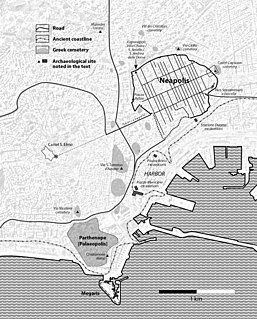
The history of Naples is long and varied, dating to Greek settlements established in the Naples area in the 2nd millennium BC. During the end of the Greek Dark Ages a larger mainland colony – initially known as Parthenope – developed around the 9-8th century BC, and was refounded as Neapolis in the 6th century BC: it held an important role in Magna Graecia. The Greek culture of Naples was important to later Roman society. When the city became part of the Roman Republic in the central province of the Empire, it was a major cultural centre.

Posillipo is an affluent residential quarter of Naples, southern Italy, located along the northern coast of the Gulf of Naples.
Running beneath the Italian city of Naples and the surrounding area is an underground geothermal zone and several tunnels dug during the ages. This geothermal area is present generally from Mount Vesuvius beneath a wide area including Pompei, Herculaneum, and from the volcanic area of Campi Flegrei beneath Naples and over to Pozzuoli and the coastal Baia area. Mining and various infrastructure projects during several millennia have formed extensive caves and underground structures in the zone.

Bagnoli is a western seaside quarter of Naples, Italy, well beyond the confines of the original city. It is beyond Cape Posillipo and, thus, looking on the coast of the Bay of Pozzuoli.
Fuorigrotta is a western suburb of Naples, southern Italy. Covering an area of 6,2 km2, it is the most populated suburb of the city.

Pianura is a western suburb of Naples, southern Italy. It is bounded on one side by the area of Soccavo and on the other side by the outskirts of the town of Pozzuoli.
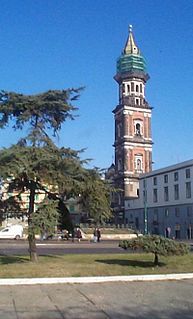
Mercato is a neighbourhood or quartiere of Naples, southern Italy. It is in the south-eastern part of the city, bounded by the industrial port of Naples on the south.

Poggioreale is a neighbourhood of Naples, southern Italy. It is at the extreme east end of the downtown Naples and includes the central train station, Naples Civic Center, Poggioreale prison, and the industrial area to the east.

Miseno is one of the frazioni of the municipality of Bacoli in the Italian Province of Naples. Known in ancient Roman times as Misenum, it is the site of a great Roman port.
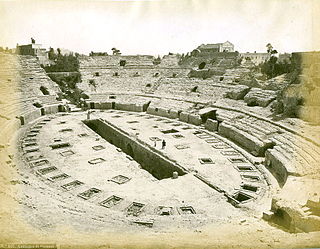
The Flavian Amphitheater, located in Pozzuoli, is the third-largest Roman amphitheater in Italy. Only the Roman Colosseum and the Amphitheatre of Capua are larger. It was likely built by the same architects who previously constructed the Roman Colosseum. The name "Flavian Amphitheater" is primarily associated with the Roman Colosseum.
Duomo is an under-construction underground metro station that will serve Line 1 on the Naples Metro. It is located near the city's main cathedral, the Duomo, for which it is named. Designed by the Italian architect Massimiliano Fuksas, the station is primarily located in a central roundabout in Corso Umberto I (Rettifilo), with secondary entrances along Via Marina and Via Duomo.
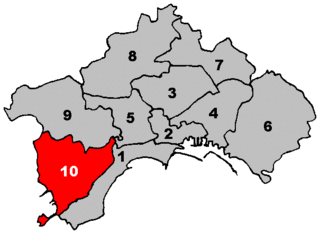
The Tenth Municipality is one of the ten boroughs in which the Italian city of Naples is divided.

The Macellum of Pozzuoli was the macellum or market building of the Roman colony of Puteoli, now the city of Pozzuoli in southern Italy. When first excavated in the 18th century, the discovery of a statue of Serapis led to the building being misidentified as the city's serapeum or Temple of Serapis.
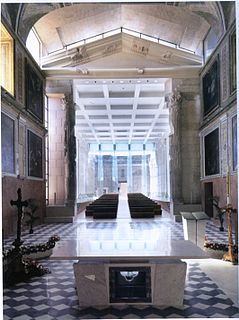
Pozzuoli Cathedral or the Basilica of San Procolo martire is the main Roman Catholic church in Pozzuoli and the seat of the Diocese of Pozzuoli. It sits at the top of the Rione Terra and is built around an ancient Roman temple.
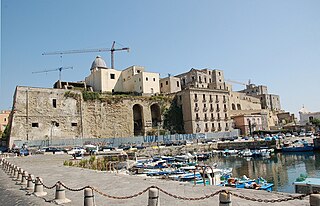
Rione Terra is a historic quarter in Pozzuoli, Italy, in the Phlegraean Fields region west of Naples. The ancient fortress originally served as the acropolis for the Greek settlement of Dicearkia before being integrated as the Roman port city of Puteoli. The densely built-up district is located on a small tufa promontory overlooking the Gulf of Pozzuoli and today serves as a tourist attraction.
Naples and its immediate surroundings preserve an archaeological heritage of inestimable value and among the best in the world. For example, the archaeological park of the Phlegraean Fields are directly connected to the centre of Naples through the Cumana railway; also the nearby sites of Pompeii, Herculaneum, Stabiae and Oplontis are among the World Heritage sites of UNESCO.